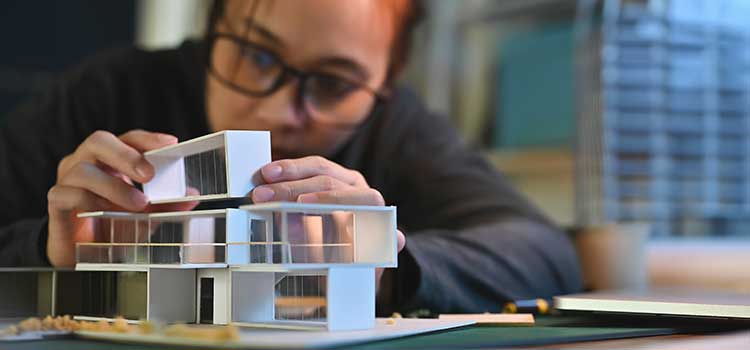Architect Portfolio Tips for Making an Impact in the Industry
Architect Portfolio Tips for Making an Impact in the Industry
Blog Article
Understanding the Diverse Profession Paths Available for Aspiring Architect
As a hopeful Architect, you have a globe of job courses awaiting you. Each course supplies one-of-a-kind obstacles and chances to apply your creative thinking and technical expertise. Whether you're attracted to typical architecture or the nuances of lasting design, there's a specific niche that straightens with your passions. Recognizing these diverse alternatives can form your expert journey, yet which direction will you choose to explore initially?
Traditional Design: Creating Structures and buildings
Traditional design focuses on designing buildings and structures that mix functionality with visual charm. Your designs can reflect social heritage, showcasing neighborhood traditions while satisfying modern requirements.
You'll create skills in preparing, model-making, and website analysis, enabling you to imagine and interact your concepts effectively. Involving with customers, you'll need to recognize their vision and equate it into viable designs.
Furthermore, constructing codes and sustainability practices are important in your work, guaranteeing your structures are ecologically friendly and secure. As you expand in your career, you'll discover chances in residential, business, and even restoration projects, each offering special challenges. Accepting traditional design leads the way for a satisfying career that pays tribute to the past while forming the future.
Urban Planning: Forming Communities and Public Spaces
As an aspiring Architect, you can play an important role as a metropolitan organizer, changing how communities function and engage. By utilizing area engagement techniques, you'll assure that citizens have a voice in shaping their atmosphere. And also, integrating sustainable layout concepts will assist create areas that not just meet today's demands but additionally safeguard the future.
Duty of Urban Planners
While several could think of architects as the sole dreamers behind structures, metropolitan coordinators play a crucial duty in forming the wider landscape of communities and public spaces. By collaborating with numerous stakeholders, you'll aid create parks, transportation systems, and domestic areas that advertise social communication and availability. Your experience in spatial design and area characteristics permits you to imagine future growth while maintaining social heritage.
Community Involvement Methods
Efficient community involvement methods are important for metropolitan coordinators to guarantee that the voices of citizens are heard and valued in the preparation procedure. To cultivate significant discussion, you must focus on open forums and workshops where neighborhood participants can reveal their concepts and issues. Usage studies and social media to reach a broader audience, ensuring varied perspectives are consisted of. Collaborating with regional organizations can improve trust and assist in much deeper connections. It is essential to offer clear details about decision-making processes and proposed tasks, allowing citizens to really feel informed and equipped. By proactively integrating and paying attention responses, you'll create areas that mirror the community's requirements, ultimately bring about more sustainable and effective city environments. Accept openness and continuous discussion for lasting impact.
Lasting Design Principles
When creating urban spaces, including lasting layout concepts is critical for creating environments that grow both environmentally and socially. Take into consideration incorporating eco-friendly areas, like parks and gardens, to enhance biodiversity and improve air quality.
Creating with water conservation in mind is likewise key-- assume regarding rain yards and permeable surface areas to manage stormwater. Involving area participants during the preparation process warranties that the spaces you produce satisfy their demands and motivate social communication. By embracing these concepts, you'll contribute to vibrant, sustainable city landscapes that profit everybody.

Landscape Design: Producing Sustainable Exterior Atmospheres
As you explore landscape style, you'll find essential layout principles that develop practical and attractive outside rooms. Lasting methods play an important function in guaranteeing these environments prosper while reducing ecological effect. And also, you'll find a range of career possibilities that allow you to make a genuine distinction in just how people interact with nature.
Design Concepts in Landscape
Recognizing design principles in landscape style is essential for developing lasting outdoor atmospheres that balance with nature. You'll need to consider elements like equilibrium, range, and percentage to assure your styles feel cohesive and welcoming. In addition, pay focus to seasonal modifications, creating with materials that complement the environments year-round.
Lasting Practices Introduction
Lasting practices in landscape design not just concentrate on appearances but likewise prioritize eco-friendly health and resource conservation. You can create rooms that promote soil health and wellness, such as making use of natural products and exercising permaculture principles. Ultimately, these practices ensure your styles profit both individuals and the setting for years to come.
Job Opportunities Expedition
With a strong structure in lasting methods, landscape architecture supplies a range of profession courses that enable you to make a visit the website significant impact on the setting. Urban planners often team up with landscape engineers to create environment-friendly areas in city settings, boosting city livability. If you're enthusiastic about education and learning, consider ending up being you could try these out a landscape architecture teacher, motivating future generations.
Sustainable Design: Concentrating On Eco-Friendly Practices
As you discover your job in design, welcoming green practices can establish you apart in an affordable field. Lasting design concentrates on creating buildings that lessen environmental influence while boosting passenger well-being. By integrating sustainable products, energy-efficient systems, and sustainable structure methods, you'll add to a greener future.
Start by getting knowledge of green certifications like LEED or BREEAM, which can boost your credentials. Consider how natural light, air flow, and thermal efficiency can maximize design. Team up with engineers and environmental consultants to innovate options that reduce waste and save sources.
Do not forget the value of community involvement-- appealing neighborhood stakeholders can inspire designs that balance with the setting. As customers increasingly prioritize sustainability, your proficiency in green practices will not only draw in tasks however additionally fulfill your passion for accountable design. Accept this vital facet of the profession, and watch your profession thrive.
Historic Preservation: Securing and Bring Back Cultural Heritage
While you begin on your architectural journey, think about the vital function of historic preservation in maintaining our cultural heritage. This area concentrates on the defense and reconstruction of substantial structures, websites, and structures that inform the tales of our past. By participating in historic preservation, you'll help safeguard the building heritage that shapes neighborhood identity.
As a historical preservation Architect, you'll examine historical value and evaluate the condition of frameworks. You'll work carefully with guardians and chroniclers to guarantee authentic reconstruction methods are used. This profession course allows you to blend creative thinking with research, enabling you to create solutions that appreciate initial materials and craftsmanship.
Your job not just adds to sustainability by reusing existing buildings however additionally fosters a feeling of satisfaction within communities. Accepting this course will aid you become a guardian of history, protecting the tales and appearances that enrich our lives.
Interior Design: Enhancing Indoor Spaces
Historical conservation and indoor style both share a commitment to enhancing the developed setting, but they concentrate on various facets. While historical preservation emphasizes keeping a framework's historical and cultural value, interior style absolutely nos in on maximizing interior rooms for capability and aesthetics.
As an aspiring Architect, you'll locate that indoor style permits you to mix creative thinking with technological abilities. You'll create areas that not only look good but also promote comfort and effectiveness. This area entails recognizing exactly how light, color, and materials interact within a room, influencing state of mind and functionality.
You'll work with various tasks, from household homes to industrial offices, ensuring that each setting fulfills the demands of its passengers. By prioritizing user experience, you can change interiors right into motivating and functional spaces, making a significant effect on exactly how people connect with their surroundings. Welcome the chance to enhance interior atmospheres and form the method people live and function.
Industrial Layout: Merging Capability With Aesthetics
Commercial design plays an important duty in producing items that effortlessly blend looks with functionality, making certain that what you utilize daily is not only visually enticing but likewise practical. As a hopeful Architect, you could the original source engage on your own in this area, concentrating on creating every little thing from furniture to consumer electronic devices. Your job involves comprehending individual needs, materials, and making procedures, enabling you to develop cutting-edge services that improve day-to-day experiences.
In industrial design, you'll commonly team up with producers, online marketers, and engineers, making sure that your styles are not only lovely yet likewise practical. You'll find out to stabilize kind and feature, prioritizing functionality without compromising style. By developing your skills in laying out, 3D modeling, and prototyping, you'll be well-appointed to bring your concepts to life. This occupation path offers a dynamic environment where creativity fulfills functionality, making it a satisfying choice for architects curious about shaping the products of tomorrow.
Regularly Asked Questions
What Educational Accreditations Do I Required to Become a Designer?
To end up being a designer, you'll require an expert degree in architecture, usually a Bachelor's or Master's. In addition, you'll have to finish a teaching fellowship and pass the Architect Enrollment Evaluation to exercise legally.
Exist Qualification Demands for Different Architectural Job Paths?
Yes, there're qualification requirements for various architectural paths. Architect. You'll require to pass examinations, total teaching fellowships, and often go after specialized training, relying on your selected focus, like landscape architecture, urban design, or historic conservation
What Software Program Abilities Are Necessary for Engineers Today?

How Can I Gain Practical Experience While Studying Style?
You can get useful experience by interning at architectural firms, getting involved in design competitors, offering for area jobs, or collaborating with classmates on real-world projects. These opportunities improve your abilities and develop important links in the sector.
What Work Opportunities Exist Outdoors Standard Design Firms?
You can discover various job chances outside standard design firms, like city preparation, interior decoration, landscape design, building and construction administration, property growth, and even functions in sustainability consulting. Each deals unique difficulties and incentives.
Whether you're attracted to typical architecture or the subtleties of lasting design, there's a particular niche that lines up with your interests.When creating city areas, incorporating lasting layout principles is vital for producing atmospheres that prosper both environmentally and socially.As you check out landscape style, you'll discover vital layout principles that develop gorgeous and useful exterior rooms.Recognizing design concepts in landscape design is necessary for producing sustainable exterior settings that integrate with nature.In industrial layout, you'll typically collaborate with producers, marketing professionals, and engineers, making sure that your styles are not just lovely yet also feasible.
Report this page